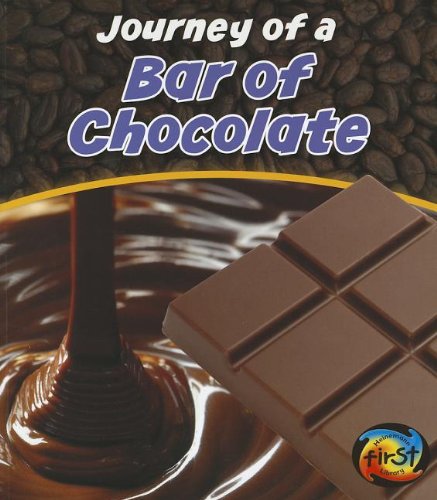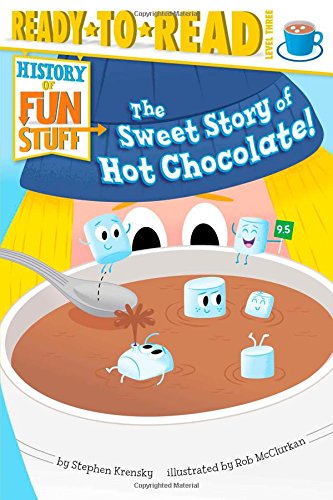No, not books made out of chocolate–books about chocolate!
Love Monster and the Last Chocolate by Rachel Bright
Flavor: sweet and funny
When Love Monster finds an entire box of chocolate, he’s torn between secretly eating the whole thing himself, and a desire to share with his friends. He’s surprised to find the box actually isn’t full, but contains just one chocolate–his very favorite–since his friends already saved it for him.
With bright (no pun intended!) illustrations and limited text on each page, this book will appeal to even young readers and chocolate eaters. Fans of this book may also enjoy Mo Willems’ Elephant and Piggie book Should I Share My Ice Cream?
The Chocolate Cat by Sue Stainton
Flavor: modern fairy tale
Through delectably detailed illustrations and a sweetly crafted story, this book offers the tale of a chocolate maker who never smiles. But one day he makes some chocolate mice with pink sugar tails. His cat takes them to all the people in the village, one by one, inspiring them to come to the chocolate shop with ideas for their own unique chocolate creations. Are the mice really magic? Or is it more a case of stone soup?
Mercedes and the Chocolate Pilot by Margot Theis Raven
Flavor: historical nonfiction, thought-provoking
If anyone thinks picture books are just for little kids, this book may inspire a new perspective! The subtitle, “A true story of the Berlin airlift and the candy that dropped form the sky” sums up this moving book with exquisite illustrations. Lt. Gail Halvorsen, one of the American pilots who airlifted food and supplies to the people of Berlin from 1948-1949, delivered candy (and hope) to the children, including Mercedes, who finally got to meet him once she was a pilot with children of her own. This book offers a unique and gentle introduction to studying World War II, and a thought-provoking look at the difference seemingly small acts of kindness can make a world of difference.
Readers who appreciate this book may also enjoy Boxes for Katje, by Candace Fleming, which also involves children sharing love and flowers with children in Europe after World War II.
Note: This book has a foreword and an afterword with many more facts about the Berlin Airlift, and the individuals in this story. These details may be too much text for young readers, but provide great info for those who are ready. Those who want even more can check out Candy Bomber by Michael O. Tunnell, which provides lots of photographs along with a more in-depth story.
How the Cookie Crumbled by Gilbert Ford
Flavor: nonfiction, entertaining
Unlike many books that cover the story of how chocolate chip cookies were accidentally invented, this picture book tackles three different tales–all possible versions of how it really happened. The author evaluates each one, examining the facts and circumstances and suggesting a conclusion (that the chocolate chips were no accident, but an invention by Ruth Wakefield, who was one smart cookie!), but still letting the readers draw their own. This fun read is a sweet way to learn a little about both history and being a discerning learner.
Grandma’s Chocolate by Mara Price
Flavor: multicultural, historical
This story, told in both English and Spanish (one set of illustrations, with both versions of the text on the facing page) is a sweet peek into the relationship between a girl and her grandma, who visits her from Mexico, bringing gifts and tales of Mayan chocolate.
Grandpa Cacao by Elizabeth Zunon
Flavor: multicultural, sweet
Inspired by the author/illustrator’s own childhood in the Ivory Coast (now officially the Republic of Côte d’Ivoire), this book traces a girl’s connection to her grandfather, a cocoa farmer she has never met (until, of course the end of the book!). It not only provides information on what it’s like to farm cocoa, but also gives a sweet connection to family history and stories, as the girl sees her own similarities to the stories of her grandfather. Do stories help your family connect to people in the past, or other parts of the world?
Curious George Goes to a Chocolate Factory
Flavor: funny
What happens when you take a curious monkey to a chocolate factory? The monkey saves the day by being a fast worker, of course!
Okay, that would totally never happen (see the nonfiction books below for information about what actually happens in a chocolate factory–and how the workers practice good hygiene!) But it makes a fun story, especially as George is able to identify the different chocolate flavors by shape. How would you decorate your favorite chocolate flavor if you could design your own?
Journey of a Bar of Chocolate by John Malam
Flavor: photographic nonfiction
With large text and ample photographs, this book tracks each stage of chocolate production, from its origins in cocoa farms, through processing, transportation, and being made into sweet candy. Readers who love to know exactly how things work, but don’t want to get bogged down with too much text, will appreciate this book.
Chocolate from Start of Finish by Samuel G. Woods
Flavor: photographic nonfiction
The best part of this book? Finding out chocolate waterfalls are real! Yes, it’s not just a Willy Wonka thing–a chocolate “waterfall” is used to pour chocolate onto candy fillings such as coconut to coat, or enrobe them. While it may not look as magic as Roald Dahl’s imagination (what does?), this book still offers a fascinating look inside the chocolate making process, with an emphasis on what really goes on inside the factory.
The Sweet Story of Hot Chocolate! by Stephen Krensky
Flavor: nonfiction
Okay, this is actually a Level 3 Easy Reader, not a picture book. But it uses plenty of pictures to illustrate the history of hot chocolate, from its origins in Central America, through Spain, France, colonial times, all the way through its use by Milton Hershey, the exploration of the South Pole, and modern day soldiers. History of fun stuff, indeed!
No Monkeys, No Chocolate by Melissa Stewart and Allen Young
Flavor: nonfiction, serious with cartoony additions
This carefully illustrated book details where chocolate comes from, and all the interconnected ecosystems that play a part in it. (Despite the title, monkeys only get one page–they help spread seeds through the forest after eating the fruit.)
CAUTION: The part on coffin flies explains how they lay their eggs on the heads of leaf cutter ants, which eat the ants’ brains when they hatch. This detail may be too gruesome (or distracting) for some readers.










